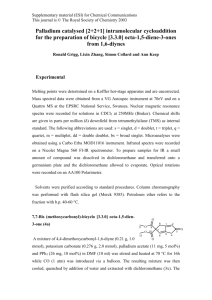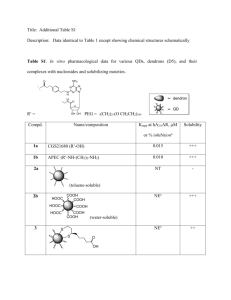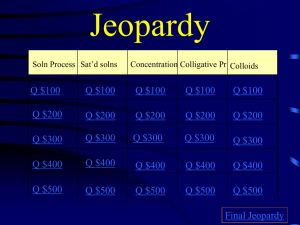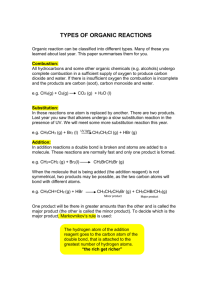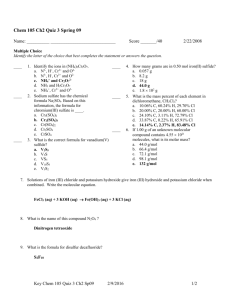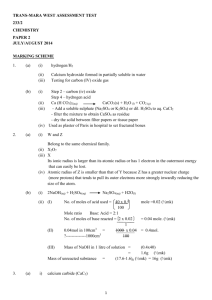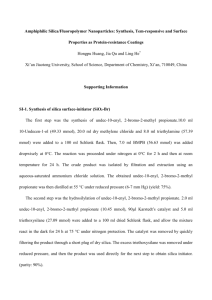Supporting Information - Springer Static Content Server
advertisement
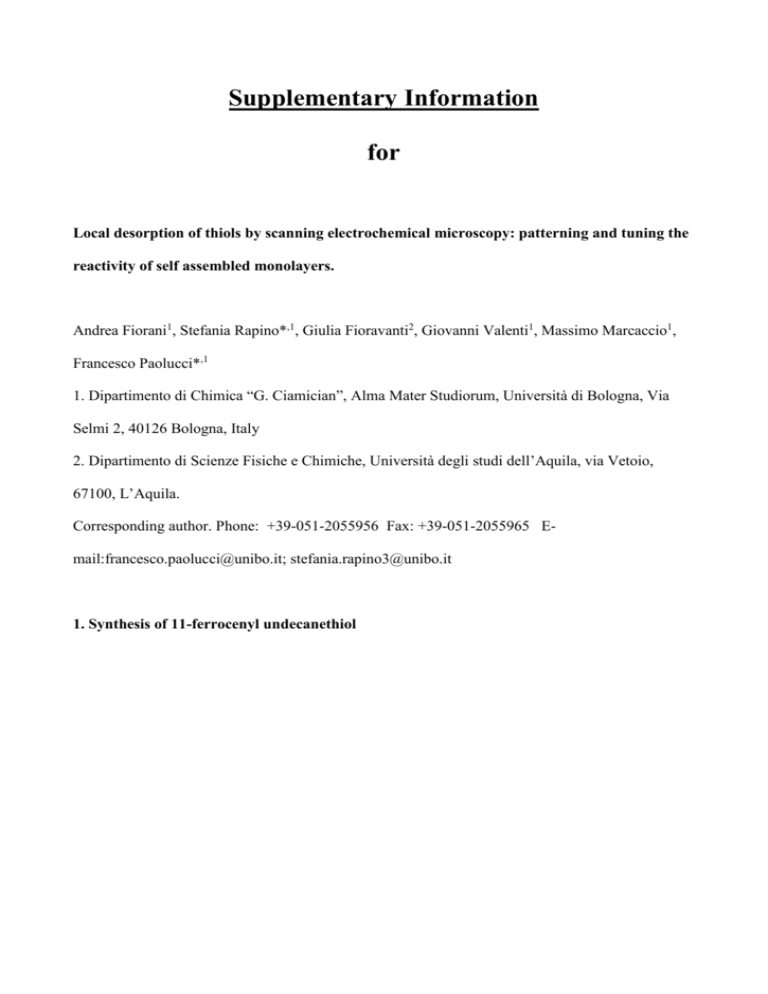
Supplementary Information for Local desorption of thiols by scanning electrochemical microscopy: patterning and tuning the reactivity of self assembled monolayers. Andrea Fiorani1, Stefania Rapino*,1, Giulia Fioravanti2, Giovanni Valenti1, Massimo Marcaccio1, Francesco Paolucci*,1 1. Dipartimento di Chimica “G. Ciamician”, Alma Mater Studiorum, Università di Bologna, Via Selmi 2, 40126 Bologna, Italy 2. Dipartimento di Scienze Fisiche e Chimiche, Università degli studi dell’Aquila, via Vetoio, 67100, L’Aquila. Corresponding author. Phone: +39-051-2055956 Fax: +39-051-2055965 Email:francesco.paolucci@unibo.it; stefania.rapino3@unibo.it 1. Synthesis of 11-ferrocenyl undecanethiol O O a Br Br OH (CH2)10 + (CH2)10 Cl 3 Fe 2 1 b Br SH (CH2)10 Fe d 6 (CH2)10 O c Fe 5 Br (CH2)10 Fe 4 Fig. S1 Summary of 11-ferrocenylundecan-1-thiol synthesis: a (oxalyl chloride, DMF, CH2Cl2, RT); b: (AlCl3, CH2Cl2, RT); c, (Zn (Hg), HCl., toluene, Δ); d (thiourea, EtOH, Δ). 1.2 Synthesis of 11-Bromoundecanoyl chloride (11-BUC) In a two-neck flask of 25 mL, under argon, 11-bromo undecanoic acid (11-BUA; Sigma-Aldrich; C11H21BrO2; MW = 265.20 g/mol; 3.75 mmol; 1.0 g) was mixed with two drops of N, Ndimethylformamide in 20 ml of anhydrous dichloromethane. Drop by drop, 2.5 ml of oxalyl chloride, dissolved in 5 mL of anhydrous dichloromethane, (C2Cl2O2; MW = 126.93 g/mol; 3.95 mmol; 0.5 g; d = 1.5 g / mL; 0.33 mL) were added and the solution was kept under stirring at room temperature for one hour, then the solvent was removed under vacuum. 1,06 g of 11-bromoundecanyl chloride were obtained (11-BUC; C11H20BrClO; MW = 283.64 g/mol; 3.75 mmol; yield 100%). 1H-NMR (, CDCl3): 3.27 (t, 2H, CH2*Br); 2.77 (t, 2H, CH2COCl); 1.72 (m, 2H, (CH2)6CH2CH2Br); 1.57 (m, 2H, (CH2)6CH2CH2COCl); 1.17 (m, 12H, CH2(CH2)6CH2). 1.3 Synthesis of the 11-Ferrocenylundecan bromide (11-FUB) In a two-neck flask of 100 mL, under argon, ferrocene (C10H10Fe; MW = 186.04 g/mol; 8.4 mmol; 1,56 g) and 50 ml of anhydrous dichloromethane, at 0 ° C, were added with 1.72 g of AlCl3 ( AlCl3; MW = 133.34 g/mol; 12.9 mmol). Drop by drop, 1.00 g of 11-bromoundecanyl chloride (11-BUC; C11H20BrClO; MW = 283.64 g/mol; 3.5 mmol) in dichloromethane (10 mL) was added and the mixture was stirred for 3 hours. Then, 150 ml of ice were added and the product was extracted with dichloromethane. The extract was washed with water, dried with anhydrous Na2SO4 and then under vacuum. The product was purified by column chromatography (eluent hexane: ethyl acetate 100: 1) to give the 11-ferrocenylundecanbromide, with a yield of 90% (11-FUB; C21H29FeBrO; MW = 433.21 g/mol; 3.15 mmol; 1.36 g). 1H-NMR (, CDCl3): 1.29 (m, 12H, CH2(CH2)6CH2); 1.69 (t,2H, (CH2)6 CH2 CH2); 1.83 (m, 2H, CH2CH2(CH2)6); 2.67 (t, 2H, CH2CH2CO); 3.38 (t, 2H, BrCH2CH2); 4.14 (s, 5H, Fc); 4.47 (bs, 2H, Fc); 4.76 (bs, 2H, Fc) 1.4 Synthesis of the 11-Bromoundecyl Ferrocene (11-BUF) In a two-neck flask of 100 ml, Zn (MW = 65.38 g/mol; 47.4 mmol; 3.1g) and HgCl2 (MW = 271.50 g/mol; 0.7 mmol; 0.2 g) were mixed in 10 ml of water and 8 ml of HCl 37%. 1.34 g of 11ferrocenylundecanbromide (11-FUB; C21H29FeBrO; MW = 433.21 g/mol; 3.09 mmol) were dissolved in 13 ml of toluene and they were added drop by drop to the amalgam, previously formed. The reaction was stirred and refluxed overnight. The flask was cooled to room temperature, the organic phase was separated, then this was washed with water and finally it was evaporated under vacuum. The residue is purified by column chromatography (eluent hexane: ethyl acetate 100: 1) to give 0.68 g of 11-bromoundecilferrocene (11-BUF; C21H31FeBr; MW = 418.21 g/mol; 1.63 mmol; yield 53%). 1H-NMR (, CDCl3): 1.34 (m, 16H, CH2(CH2)8CH2); 1.90 (m, 2H, CH2CH2(CH2)8); 2.37 (t, 2H, (CH2)8 CH2Fc); 3.44 (t, 2H, Br CH2CH2); 4.09 (bs, 4H, Fc); 4.14 (s, 5H, Fc). 1.5 Synthesis of the 11-Ferrocenylundecanthiol (11-FUT) In a two-neck flask of 100 ml, under argon, 0.68 g of 11-bromoundecylferrocene (11-BUF; C21H31FeBr; MW = 418.21 g/mol; 1.63 mmol) and 0.12 g of thiourea (CH4N2S; PM = 68.57 g/mol; 1.78 mmol) were dissolved in 10 ml of EtOH and the solution was refluxed for 18 hours. The solvent was removed under vacuum, then 10 ml of water and 0.1 g of KOH (MW = 56.1g/mol; 1.78 mmol) were added and solution was refluxed for 2 hours. The aqueous phase is extracted three times with 25 ml of ethyl ether, dried with anhydrous Na2SO4 and the solvent was removed under vacuum. The residue is purified by column chromatography (eluent hexane: ethyl acetate 100: 1) to give 0.21 mg of 11-ferrocenylundecanthiol (C21H32FeS; MW = 372.39 g/mol; 0.57 mmol; yield 35%). Initially, the product had the appearance of an oil, which slowly crystallized to give orange crystals. 1H-NMR (, CDCl3): 1.31 (m, 16H, CH2(CH2)8CH2); 1.63 (m, 2H, CH2CH2(CH2)8); 2.34 (t, 2H, (CH2)8 CH2Fc); 2.70 (t, 2H, SH CH2CH2); 4.07 (bs, 4H, Fc); 4.12 (s, 5H, Fc). 2. Fitting Procedures, Heterogeneous Rate Constants, Image Plotting and SECM experimental details MIRA software by Prof. Wittstock (http://www.uni- oldenburg.de/chemie/pc2/pc2forschung/secmtools/mira/) was used for fitting all current approach curves and for plotting all the images. Approach curves were fitted by Cornut-Lefrou equations for purely negative feedback, purely positive feedback and for finite sample kinetics, tip/substrate separations and heterogeneous rate constants were accordantly evaluated. A first order heterogeneous rate constant in cm per second (keff) can be determined using the dimensionless constants, obtained in the fitting procedures and reported in the text, accordingly to the following equation: k=keff rT/D where rT is the electrode radius and D the diffusion coefficient of the redox specie. Each of the approach curve plotted is representative of a series of three SECM measurements. The L=0 distance (L= d/a, the tip–substrate separation normalized by the tip radius) is obtained by experimental touching point and by fitting the experimental approach curve with MIRA software. 3. SAM pattern stability over time 1 2 3 4 5 6 7 Fig. S3 Image 1 was recorded after a few minutes from pattern fabrication, from 2 to 6, SECM images were recorded every one hour and image 7 was recorded 24 hours after 6. 4. Width determination of desorbed area In order to estimate the width of the circular desorbed area a single SECM scan was recorded at the centre of two spots and result is showed in Fig. S4. The diameter was measured between the two edge of the spot where the current starts to increase. Fig. S4 Scan over two desorbed spot in the x direction. Arrows indicate the point where the width is measured. Bibliography 1. Shepherd J L, Kell A, Chung E, Sinclar C W, Workentin M S, Bizzotto D (2004) J Am Chem Soc 126:8329–8335 2. Kondo T, Horiuchi S, Yagi I, Ye S, Uosaki K (1999) J Am Chem Soc 121:391–398 3. Creager S E, Rowe G K (1994) J Electroanal Chem 370:203–211 4. Wittstock G, Asmus T, Wilhelm T (2000) Fresenius J Anal Chem 367:346–351 5. Cornut R, Lefrou C (2007) J Electroanal Chem 608:59–66 6. Cornut R, Lefrou C (2008) J Electroanal Chem 621:178–184.

